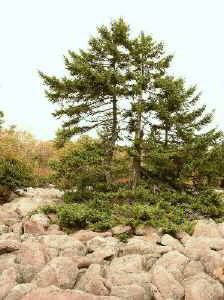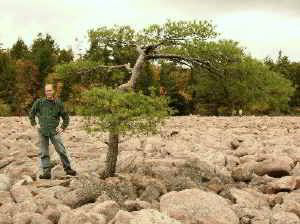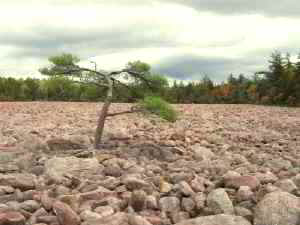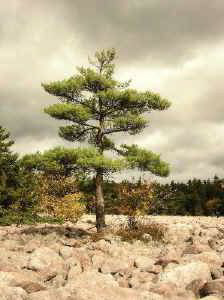ENTS
On October 16, on the way back from the Forest Summit III, Carl
Harting and
I stopped at Hickory Run State Park in eastern Pennsylvania. The
park is a
National Natural Landmark because of an extensive peri-glacial
boulder
field present in the park. Essentially during the last ice age
this area
was on the edge of the glacier, but not itself glaciated.
Freeze-thaw
processes broke the bedrock into numerous boulders ranging from
pebbles
to small house sized, predominated by boulders in the 1 to 5
foot diameter
range. Smaller particles were removed leaving just a matrix of
boulders
behind. Initially the area covered by boulders was much larger,
but over
the past 11,000 years the edge of the forest has creeped inward,
slowly
filling the spaces between the boulders with leaves, woody
debris, and
collected sand along the edges of the boulder field. Currently
the boulder
field occupies an unbroken area 1800 by 400 feet in size. The
field itself
is completely flat. The headwaters of Hickory Run originate
under the
boulders in this area. I had visited the area maybe ten years
ago and I
remembered gnarled looking trees growing at the edge of the
boulder field
and here and there within the boulder field itself. The park was
only 8
miles or so off the interstate and I wanted to check it out.
 Photo by Ed Frank
Photo by Ed Frank
It was rainy when we left Massachusetts early Sunday morning.
Traffic
wasn't bad and we made good time until we crossed the Delaware
River. As
soon as we entered Pennsylvania we turned southward on 209. This
road runs
parallel to the Delaware River through the Delaware Water Gap.
There were
forests along the road, but from the highway we did not see any
large-sized
or old looking trees. But exploring the Delaware Water Gap is
another
trip, we were headed to Hickory Run. Eventually we were back on
Interstate
80 headed westward. As we approached the area of the park
turnoff for
miles the tops of trees along the road were broken off - some
recently some
appeared to have been broken off much longer. It is as if this
is a
reoccurring theme in this area. I don't know any specifics.
 Photo by Ed Frank
Photo by Ed Frank
Carl Harting
beside a pine tree
We turned off I80 toward Hickory Run. Tree tops were still
commonly
broken. After a quick stop at the park headquarters to get a
booklet, we
drove back to the boulder field. There were quite a few cars
parked there,
but we were anxious to venture forth anyway. There
is an interpretive
sign explaining the origin of the boulder field - then just
beyond the
boulders themselves. This expanse of pink boulders stretching
out into the
distance was impressive. You sort of hop and step from one
boulder to the
next as you cross the field.
 Photo by Carl Harting
Photo by Carl Harting
I wanted to first reach an island
of trees
directly across from the entrance to the field. There was a nice
clump of
white pine, red maple, spruce, birch, and rhododendron. It was
clear to
anyone the trees were gnarled and were growing slowly. I took a
few photos
and moved on to the next clump. The trees were beautiful
standing starkly
against the boulder field. The maples and birches were colored
red and
yellow in full fall foliage. At one point a group of little
girls - likely
Brownies dressed in pink sweat suits was clambering among the
boulders
adding a contrasting splash of color. What I didn't see however
were any
indications that any of these trees were of great age. I am not
sure what
would have told me they were old, but they just didn't look all
that
ancient.
 Photo by Ed Frank
Photo by Ed Frank
A visitor can hike anywhere across the surface of the boulder
field itself
and a hiking trail leads around the perimeter of the entire
field. It is
certainly worth the trip. The entire area around the boulder
field was
covered by relatively young second growth forest. Wind had
clipped the
tops of most of the trees and branches were down everywhere.
This attests
to the harsh conditions withstood by the trees on the edge of
the boulder
field itself. Within the surrounding forest were all of the
oaks, maples,
American chestnut, sassafras, birch, pine, hemlock represent a
pretty
diverse array of trees. It is a place worth visiting if you have
a chance
- who knows perhaps the trees really are old and I couldn't tell
the
difference. (Photos will be posted to the website)
Edward Frank
|